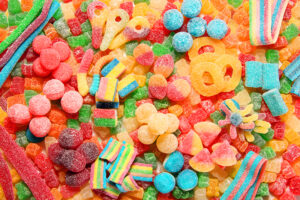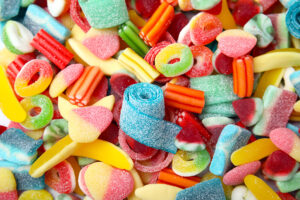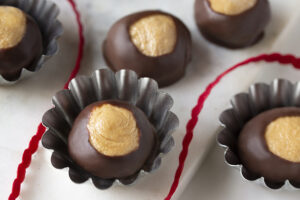How Sweet It Was (Part 2)
By Michele Bazan Reed | bazanreed@hotmail.com
 Charles M. Schulz, the creator of the “Peanuts” comic strip, is reputed to have said, “All you need is love. But a little chocolate now and then doesn’t hurt.”
Charles M. Schulz, the creator of the “Peanuts” comic strip, is reputed to have said, “All you need is love. But a little chocolate now and then doesn’t hurt.”
As with most of his messages, there’s a whole lot of wisdom behind the joke.
If you’re like me, the magic of chocolate — indeed, any candy — is how it can bring back, in a single taste, the sweetest moments of our childhood.
A piece of ribbon candy transports me back to Christmas Eve at my grandmother’s house, where the evening concluded with passing a plate of the jewel-like confection, always accompanied by a warning: “Be careful! It’s sharp!”
The sweet-tart taste of conversation hearts evokes memories of Valentine’s Days in St. Stanislaus elementary school. And chocolate is a magic portal to every Easter I’ve lived through: chocolate bunnies I loved as a child, standing in line for Stone’s homemade candies in Oswego for my kids’ Easter baskets and cross-shaped chocolates, in a basket with our Easter feast, covered by a cloth embroidered by my mother, and blessed at church on Holy Saturday.
Remember the candy counters at mom-and-pop grocers, or in freestanding candy stores? Glass jars like fishbowls sat row on row on counters or shelves, watched over by a proprietor used to sticky fingers in more than one sense of the word. Those magical jars gave us kids a clear view of the temptations waiting inside. This “penny candy” really was a cent when I was growing up in the ’50s, but even when prices rose, it retained the name.
And oh, what treasures you could get for your handful of copper coins: atomic fireballs that lasted all afternoon, if your lips could stand the burning sensation that long; Tootsie Rolls, red hot dollars and licorice in a multitude of shapes from ropes to pipes.
 A variation on this form of the candy counter was candy by the pound. Each type of candy sat in a little bin, dozens next to each other on tables in the center of the space. You transferred your favorites into a small paper bag using a little scoop — or carefully chose each piece by hand — and the shopkeeper weighed your treasures at the end of the line. The method is still used in some supermarkets that boast bulk food sections.
A variation on this form of the candy counter was candy by the pound. Each type of candy sat in a little bin, dozens next to each other on tables in the center of the space. You transferred your favorites into a small paper bag using a little scoop — or carefully chose each piece by hand — and the shopkeeper weighed your treasures at the end of the line. The method is still used in some supermarkets that boast bulk food sections.
Just waiting to be scooped up were orange and black-wrapped peanut butter taffy, root beer barrels, butterscotch drops and Bull’s-Eyes: those iconic treats with a white creamy center, surrounded by a chewy ring of caramel. My mom loved the Bull’s-Eyes and I was pretty sure I could find one or two in the bottom of her purse on any given day.
Remember the little Kraft Caramels and Fudgies? They were perfectly shaped little cubes, wrapped in clear cellophane. They were soft and chewy and packed a real flavor punch.
Round out your bag with some lemon drops, strawberry candies, jawbreakers and little rectangular slices of nougat dotted with colorful dried fruit or bits of nuts.
Other treats were sold unwrapped and loose in bulk: bridge mix; swirly chocolate stars; and nonpareils, dark chocolate discs with white round sprinkles (Fun fact: The sprinkles themselves are also called nonpareils and in some regions they go by name “hundreds and thousands.”) And of course, there were the “French burnt peanuts” with a thick and lumpy dark red candy coating.
 Taffy was and is a popular candy. Some oldies but goodies are still available. Mary Jane is a peanut butter and molasses taffy that debuted in 1914, sporting a yellow and red wrapper showing a little girl in an old fashioned dress and bonnet. The real Mary Jane is said to be the inventor’s favorite aunt.
Taffy was and is a popular candy. Some oldies but goodies are still available. Mary Jane is a peanut butter and molasses taffy that debuted in 1914, sporting a yellow and red wrapper showing a little girl in an old fashioned dress and bonnet. The real Mary Jane is said to be the inventor’s favorite aunt.
That chewy treat is matched by Bit-O-Honey, one of my favorites. It’s a honey flavored taffy with little pieces of almond embedded in it. The trademark bee still graces the bar’s iconic wrapper.
And the biggest name in the taffy category was Bonomo Turkish Taffy. From its start at Coney Island in 1912, it grew to be wildly popular mid-century, perhaps because of its catchy jingle touting “B-O-N-O-M-O, oh oh oh, It’s Bonomo Turkish Taffy.” Or maybe its appeal was its interactive nature. To eat the taffy, commercials instructed, chill it in the fridge for a minute, then place the bar in your palm and slam it on the table to break it into several pieces.
Speaking of fun things to do with candy, nothing can top the play factor of the popular wax candies. Nik-L-Nip, named for its five cent price tag, was a little wax bottle filled with a colorful syrup. You’d bite the tip of the neck off and drink the liquid inside. Then you could chew the empty wax bottle like gum, wasting nothing.
The second wax candy thrilled generations of kids and is still available today. It’s none other than Wack-O-Wax lips, the bright red wax disguise that came in two forms: red lips like a mid-century Hollywood bombshell, and wax fangs, that staple of homemade Dracula costumes every Halloween. Camp it up or scare your victims, then enjoy a nice leisurely chew of the waxy treat.
All these novelty treats were fine and dandy, but there’s no denying the king — or queen — of the confectionary world is the good old chocolate bar. From a simple slab of milk chocolate to bars studded with almonds, filled with caramel, coconut or peanut butter, Americans have always loved a good chocolate bar. Charleston Chew, Three Musketeers, Snickers, Hershey’s, Crunch, Mounds, Baby Ruth or Butterfingers, you can’t go wrong with the simple, portable pleasure of a chocolate bar.
So grab your favorite chocolate bar and settle in to enjoy World Chocolate Day July 7. Or if you miss that, there’s always National Milk Chocolate Day July 28. Or International Chocolate Day Sept. 13, National Chocolate Day Oct. 28 and National Chocolate Candy Day Dec. 28. But who needs a special holiday to enjoy the simple pleasure of theobromine — a chemical component of chocolate whose name means “food of the gods”?
Candy in all its forms makes our world a little bit sweeter.
Opportunities to Eat Chocolate
Grab your favorite chocolate bar and settle in to enjoy World Chocolate Day July 7 or the National Milk Chocolate Day July 28. Or International Chocolate Day Sept. 13, National Chocolate Day Oct. 28 and National Chocolate Candy Day Dec. 28.

